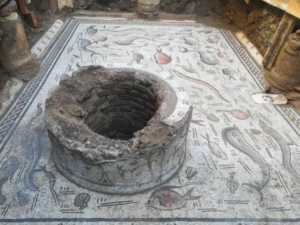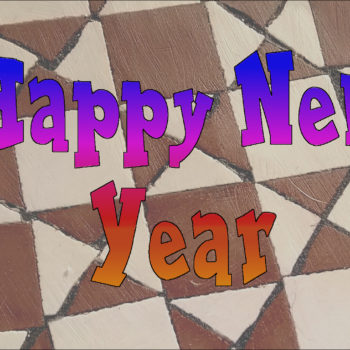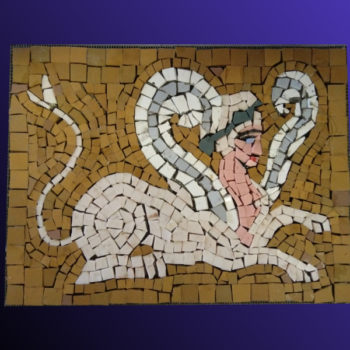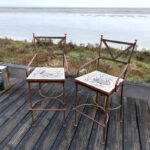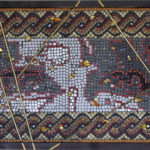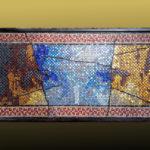A unique mosaic.
This unusual Roman mosaic was discovered discovered in Cantillana, a Sevillian town, and can be seen on weekends – Saturday and Sunday – from 6:30 p.m. to 8:30 p.m. at the local history center.

The huge Roman mosaic of the 3rd century AD, found in the Sevillian town of Cantillana during works in Sacristán José Díaz Hidalgo street, can already be visited. The piece, known as the House of Dolphins or Terramar, is currently in display and you can see it in Cantillana during the week.
The mosaic was discovered in November 2017 and since then it has been in rehabilitation to study its history and make it available to the public. Once it is fully documented, it will be relocated where it was extracted. The mosaic, in great state of conservation, displays impressive representations of marine animals and creatures surrounding a well. With this discovery, we are learning a lot about the Roman city of Naeva.
According to Experts “there is no other known mosaic of this type”.
The archaeologist José Antonio Valiente de Santis, one of the workers who have investigated the discovery, explains: “The mosaic represents a seabed with a small island – represented by the well – surrounded by a series of figures probably involved in a Bacchic scene and one of them is likely the god Bacchus himself”
According to Valiente, the decorative marine theme is “of Roman taste, very common. There are many representations since the first century BC, in the Greek world too … “. In his opinion, the image represents an island populated by a series of characters and surrounded by an ocean full of fishes, where “the figures of the dolphins are the most striking.”
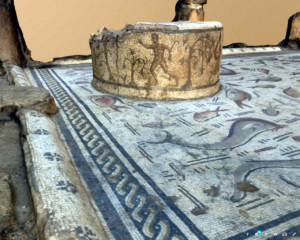
“The degree of conservation of this mosaic is excellent. It is complete but for a small corner. There is no other example of such a piece in the Roman world. If there are others, they have not been found yet. “Valiente points out.
The expert goes on : “It seems that several artists intervened, who reproduced similar patterns. We can see the same dolphins in Extremadura. This allows us to identify points of connection on the territory, places of commercial and intellectual exchanges. In the Roman world artists went from place to place with their designs, ideas and representations.”
You can visit the mosaic at its present location
After the discovery the mosaic was moved to the city’s history center where a team of nine professionals has been working on it. They completed its restoration at the end of September 2018.
The mosaic is presently displayed and can be admired at the Local History Center on weekends – Saturdays and Sundays – from 6:30 to 8:30 p.m. It can also be visited during the week with prior reservation.
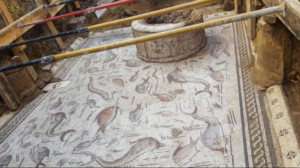
As soon as possible, the mosaic will be relocated to its site and integrated in a large interpretation center.
3D reconstruction to facilitate documentation and dissemination work
After months of rehabilitation, researchers have developed a 3D figure where the mosaic is displayed in great detail. “All the work that has been done with high precision imaging machinery,” argues the archaeologist. “We managed to build a very detailed 3-dimensional representation. It will greatly help further scientific studies.”
Archeology increasingly makes uses this visualization technology which facilitates the work of documentation and dissemination.
At this link you can see the find in 3D.

Domus or School ?
Valiente believes the mosaic, covered with water, was paving the courtyard of an outdoor Roman building. “It was an atrium, composed of eight columns supporting a roof that surrounded it. Only the mosaic was exposed to the open sky”. The space could not be crossed, but had to be skirted and was only accessible to be cleaned. This “helped keep it well preserved,” he says.
There are several hypotheses about the nature of the building:
- a domus – family home – is the “most understandable”;
- a school or the headquarters of an association of professionals related to the river.
“Various hypotheses float in the air which we cannot verify at this time. One likely explanation is that the Roman building is a domus”, concludes the archaeologist.
Naeva : a strategic city between Cordoba and Seville
With this mosaic the Roman city of Naeva “has been found for the first time.” Perhaps because “there had been no previous excavations in the old town,” says the archaeologist.
The Roman Naeva was an important river port and there is evidence of a guild of Naevenses boatmen. Archaeologists found numerous Roman remains in the area : statues, tanks, inscriptions, and pipes in La Fuente, north of town.
With this decorative find, archaeologists believe they have now precisely located the Roman Naeva, a “very strategic” city which we know was located between Cordoba and Seville on the Guadalquivir River.
